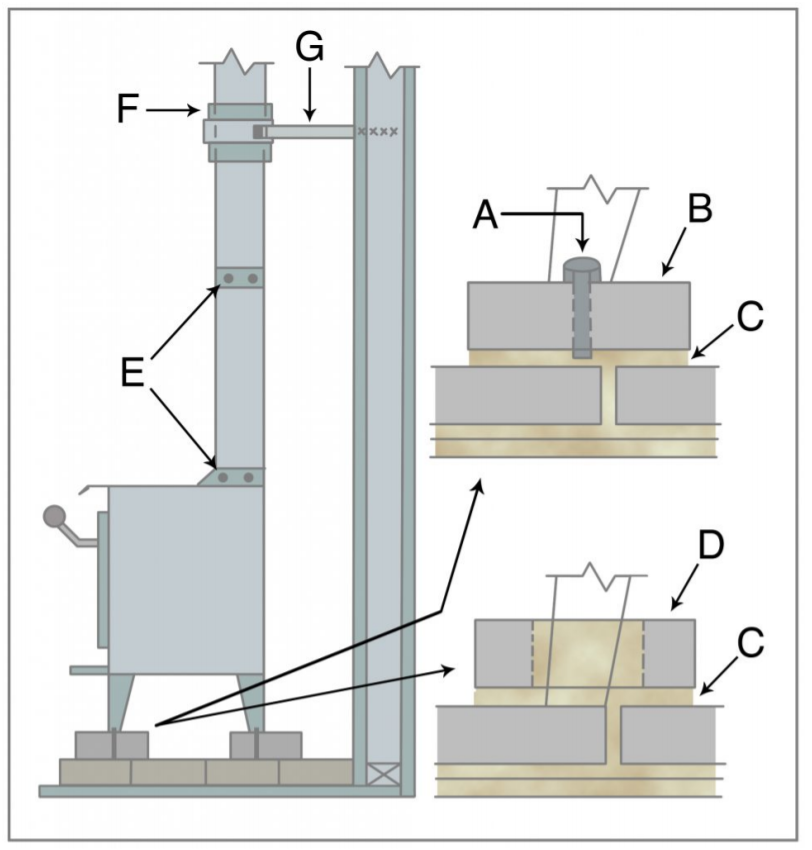7.2.9: Bricks, Stonework, and Other Time Bombs
- Page ID
- 6249
Overview
If you live in an old, unreinforced brick house, you are in real danger, and none of the retrofit techniques mentioned above will do much good outside of a major costly reinforcing job. Fortunately, old brick houses in the Pacific Northwest are being phased out of the building inventory; most of us live in wood-frame houses.
But one part of your house is still likely to be unreinforced—your masonry chimney (Figure 11-13). Chimneys collapse by the hundreds during major California earthquakes. Many chimneys were damaged during the Nisqually Earthquake, and one collapsing chimney seriously injured Curtis Johnny inside his apartment. Most commonly, chimneys snap at the roofline. A tall chimney is likely to be set in motion by earthquake waves, resulting in collapse. The taller the chimney, the more likely it is to fall through the roof into your house. Some recent building codes require internal and external bracing of chimneys to make them more likely to survive an earthquake.

Even if your chimney didn’t fall during the earthquake, it might have been damaged, partially or completely blocking the flue. If this happens, gases produced by your furnace, including carbon monoxide, may enter your house, possibly enough to kill you. How do you know you have a problem unless you have a carbon monoxide detector? Your family might become ill in the house. Another clue is water-vapor condensation on your windows, a product of burning natural gas that is not vented properly. Has your chimney been checked by a professional, even if it looks okay after the earthquake? Install a detector.
A good rule of thumb is to consider how much of a threat your chimney poses. If someone could be killed or severely injured by a falling chimney, take it down. Prefabricated metal chimneys can be attached to an existing brick firebox so that no brick projects above the roofline.
Inside the house, there’s the mantel. The mantel may be fieldstone—very attractive, but very heavy if it fails, particularly if the mortar has been weakened by a chimney leak. Fieldstone and brick veneer on the outside of the house may pose a hazard as well. If you want a natural stone appearance, install the lightest-weight material you can.
Freestanding wood-burning stoves are popular in the Pacific Northwest. A study done by Humboldt State University found that more than half the wood-burning stoves in the area near the epicenter of the April 1992 M 7.1 Cape Mendocino Earthquake moved during the earthquake, and several fell over. Fire codes in some states leave stoves unsupported on all four sides, which might cause them to slide or turn over during an earthquake. If a stove tips over and separates from its stovepipe, cinders or sparks can cause a fire.
The following steps are recommended (Figure 11-14). (1) Anchor a stove resting on a brick hearth, attaching the stove legs to the hearth with bolts. Mobile-home-approved stoves have predrilled holes in the legs for anchoring to the floor framing. (2) Anchor a stove resting on a concrete slab directly to the concrete. (3) Anchor the stovepipe to the flue, and tie together each of the stovepipe segments.


In the Kobe Earthquake, thousands of people were killed in their beds in wood-frame houses because their roofs were of tile, which made the houses top-heavy and more subject to collapse. Clay tile roofs are the heaviest; composition or wood roofs are lighter. If you reroof your house, add plywood shear panels over the rafters. This is often required in new construction and might be required if you remodel. It strengthens the house.


